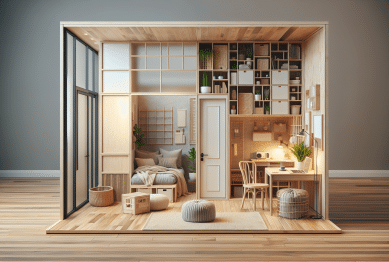Uncover the practical side of minimalist living and see how it can transform daily routines, boost well-being, and elevate comfort. This in-depth guide explores small-space organization, mindful design, decluttering hacks, and habits for sustainable simplicity—creating a lifestyle with less stress and more meaning.
The Essence of Minimalist Living
Minimalist living extends beyond owning fewer possessions. It’s about intentional choices that create more space, time, and peace of mind. Embracing this lifestyle can lead to a sense of freedom for many. By evaluating what truly adds value, individuals can shape their homes and routines with clarity. This approach helps reduce stress by eliminating unnecessary distractions and focusing on essentials. In minimalist living, aesthetics meet function, allowing for cleaner lines, open spaces, and a calming atmosphere. The journey begins with a decision to simplify—not just the home, but also habits and mental clutter. Adopting minimalism can be nuanced, flexible, and deeply personal. While it’s a trend in lifestyle and entertainment discussions, the benefits are practical and lasting. Learning to let go can be empowering, especially when tied to environmental awareness and sustainability. Minimalism is not about sacrifice; it’s about discovering what matters most and making it the centerpiece of daily life.
A key appeal in minimalist living is reduced decision fatigue. When surrounded by only items that serve a purpose or spark joy, making choices becomes easier. Everyday routines feel lighter and less chaotic. This can enhance productivity and provide an emotional lift, especially in fast-paced urban environments. Mindful purchasing decisions play a critical role. Instead of impulsively acquiring new gadgets or decor, minimalist enthusiasts research and select pieces carefully. Some even adopt the popular “one in, one out” rule to maintain balance. Minimalism isn’t about deprivation; rather, it’s about cultivating abundance through less. Minimalist living can be tailored, from extreme approaches—owning just 100 items—to gentle modifications such as clearing tabletops or reducing digital noise. Everyone’s minimalist journey is unique. What remains consistent is the promise of a more intentional and fulfilling lifestyle grounded in simplicity.
For many, the motivation to try minimalism arises from overwhelm or discontent with clutter. Science backs up the relief people report after decluttering spaces—a tidy environment can improve mood and self-esteem (Source: https://www.ncbi.nlm.nih.gov/pmc/articles/PMC4809932/). Minimalist homes often feel like sanctuaries, providing a safe haven from external chaos. Moreover, minimalism integrates with other lifestyle movements, such as slow living and sustainable design. It becomes a catalyst for deeper lifestyle changes, prompting careful reflection on values, habits, and long-term priorities. Embracing this philosophy is less about following strict rules and more about building a home that uplifts, rather than drains. As minimalist living gains visibility in mainstream media, more people seek guidance for the first steps—proof that the desire for simplicity remains timeless and universal.
Decluttering Hacks that Spark Joy
Decluttering is central to minimalist living and can feel daunting, especially for those new to the process. However, starting with small areas—like a single drawer or shelf—creates momentum. Many find Marie Kondo’s famous question, “Does it spark joy?” helpful in making tough decisions about what stays and goes. Sorting belongings into keep, donate, and discard piles is an efficient way to visually assess progress. While decluttering isn’t a once-and-done event, regular tidying habits help minimalist spaces remain inviting. Some experts recommend timing sessions with music or setting a timer to make the process lively and focused. Documenting before-and-after transformations can be rewarding and fuel further action. Above all, decluttering must be a personalized journey, guided by emotion and intention.
Specific hacks can simplify decluttering routines. For example, organizing by category instead of room allows for a comprehensive purge—gathering all clothing, books, or kitchen gadgets together to evaluate quantity and redundancy. Minimalist living also adjusts storage solutions with clear containers or labels, keeping frequently used items visible and easily accessible. Many opt for multi-use furniture to streamline living spaces. It can be liberating to pare down digital clutter as well—deleting unused apps, unsubscribing from promotional emails, and organizing desktop files. Families might involve children in decluttering tasks, teaching the value of mindful consumption early. Decluttering isn’t only about physical possessions; it can include letting go of old habits or limiting exposure to negative media, enhancing overall well-being.
Sticking to a set schedule for reevaluating belongings—perhaps every season—prevents slow buildup of unnecessary items. Some minimalist enthusiasts use the “box method,” placing unused items in a box for several months; if belongings go untouched, it’s a sign they aren’t needed. Others embrace the “capsule wardrobe” concept, curating outfits that mix and match efficiently. The aim is not just to declutter, but to reshape consumption patterns long-term. As the minimalist movement grows, so do online communities offering support, ideas, and creative organization tips (Source: https://www.apa.org/monitor/2023/01/decluttering-benefits). These resources prove invaluable for those seeking guidance, accountability, or inspiration. Minimalist living invites practical changes that ripple outward—improving mood, finances, and even environmental impact.
Small Space Solutions and Organization
City dwellers, students, and families alike benefit from small space solutions that align with minimalist design. Living in tight quarters doesn’t mean sacrificing comfort. Instead, it encourages inventive layouts and multifunctional furniture choices. Wall-mounted shelves and foldable desks offer more floor space. Vertical storage is a popular strategy, keeping items tidy and off crowded surfaces. In the kitchen, stacking containers and magnetic spice racks make prep areas sleek and efficient. Designers recommend maximizing natural light to make small rooms feel spacious and inviting. Color schemes also matter—light hues amplify openness, while subtle accents showcase personality without overwhelming the senses. Minimalist living thrives in small environments where every square foot is considered and cherished.
Tidiness is easier to maintain with simple storage rules. The “everything has a home” method ensures quick cleanups and less visual clutter. Rolling carts are versatile, easily shifting between office, bathroom, or dining use. Under-bed storage drawers offer stealthy solutions for linens or out-of-season clothing. For those working from home, concealed cable organizers and compact workstations turn even corners into functional spaces. Small-space organization benefits from regular purging of seldom-used items, ensuring that storage stays purposeful, not packed. Plants add life and color, creating a cozy vibe even with few accessories (Source: https://www.houzz.com/magazine/10-of-the-best-small-space-tricks-we-learned-this-year-stsetivw-vs~141660570).
Minimalist organization hacks work well across all lifestyle stages. Young professionals might love convertible sofas or Murphy beds, while families gravitate toward toy rotation or wall hooks for backpacks and jackets. Small bathrooms maximize space with over-the-door racks or magnetic strips for grooming tools. The right blend of aesthetics and utility builds a harmonious environment, no matter the apartment size. Smart devices and wireless solutions reduce visual clutter and enhance functionality. Ultimately, minimalist organization is about creative adaptation—finding what suits individual routines and spaces. Reflecting on needs instead of wants keeps small spaces flexible and enjoyable for the long term.
Mindful Design and Decor Choices
Minimalist design isn’t bland; it thrives on mindful curation and harmony. Choosing quality over quantity is the primary principle. Investing in timeless pieces helps reduce frequent replacements or impulsive purchases. Neutral palettes and clean silhouettes set the foundation for tranquil interiors, while select decor—perhaps a statement plant or handcrafted pottery—offers warmth. Texture becomes a substitute for color, inviting tactile experiences and cozy vibes. In the living room or bedroom, minimalism favors open space, with decor positioned intentionally rather than in clusters. Each element feels purposeful, drawing the eye without overwhelming it. This design language is accessible for all, regardless of budget. Even DIY projects can add a personalized touch, promoting sustainable choices.
Streamlined decor can align with eco-conscious values. Upcycling vintage finds, using natural fibers, and supporting local craftspeople reduces waste while enhancing style. Minimalist design is linked to positive mood shifts, as uncluttered surroundings promote relaxation and focused attention (Source: https://www.frontiersin.org/articles/10.3389/fpsyg.2019.02965/full). Scent diffusers, soft lighting, and natural materials help personalize the space while keeping it peaceful. Minimalism can inspire creative hobbies as well: a single art print or handmade blanket stands out beautifully against a neutral background. The home then feels curated, not crowded. For households with children, minimalist design can foster calm routines and easy-to-maintain play zones. Displaying a rotating selection of children’s art or toys, rather than everything at once, brings fresh energy without clutter.
Ultimately, mindful design nurtures an intentional relationship with living spaces. Refreshing decor doesn’t demand frequent spending—simply rearranging furniture, using multipurpose items, or bringing in nature through houseplants creates visual excitement. Many minimalists take inspiration from Japanese or Scandinavian interiors, which prioritize function, balance, and comfort. Incorporating these principles means making deliberate decisions that serve both beauty and practicality. Mindful design radiates beyond the home, encouraging minimalism in workspaces or even digital devices. Over time, these habits become second nature, supporting a simpler and more joyful lifestyle.
Building Lasting Minimalist Habits
Minimalist living succeeds when transformed into daily habits. Instead of a one-time project, minimalism flourishes through small routine changes. A morning ritual might include making the bed for an instant sense of order. Evening routines can involve resetting shared areas, ensuring a calm start to the next day. Through repetition, decluttering and mindful consumption become natural behaviors. Using calendars or simple to-do lists helps reinforce minimalist patterns, especially for those with busy schedules. It’s valuable to reflect regularly on what is working—and what might need adjustment. By focusing on habits, lifestyle changes remain sustainable and rewarding.
Intentional purchasing is another cornerstone of lasting change. Before bringing new items home, pausing to consider need and utility helps prevent clutter from returning. Minimalists might set monthly spending limits, practice gratitude for what they already own, or choose meaningful experiences over additional objects. Shared household rules—like a “clutter basket” for quick pickups—foster family cooperation. Friends and roommates can join the journey, trading ideas and accountability. Over time, these reflexive habits reinforce a positive cycle, making minimalist living effortless rather than restrictive.
Minimalism also extends to social and digital spaces. Many simplify calendars by declining unnecessary commitments or limiting screen time before bed. Trimming phone apps and unfollowing overwhelming social media accounts heightens focus and reduces anxiety (Source: https://www.helpguide.org/articles/mental-health/social-media-and-mental-health.htm). Practicing gratitude and mindfulness, even in small acts, helps root daily life in contentment rather than comparison. Minimalist habits are flexible—adjustable for solo dwellers, couples, or families. With consistent effort, minimalist living unlocks clarity, peace, and freedom in every sphere of life.
Sustainability and the Minimalist Mindset
Living simply often means consuming less and wasting less. The intersection of minimalism and sustainability is growing, with many seeking a lighter environmental footprint. Fewer purchases translate to less production and ultimately, less landfill waste. Choosing durable goods and supporting eco-friendly brands can amplify these efforts. Composting, recycling, and reducing single-use plastics enhance minimalist values. By consciously choosing what to acquire, individuals contribute to global stewardship. Trends such as upcycling, thrift shopping, and embracing the secondhand economy align with both minimalist and sustainable ethics.
For some, sustainability becomes a guiding principle behind every decision. Rather than chasing the newest trends, minimalists seek out classic, long-lasting items. Learning to repair belongings delays disposal and saves money. Digital minimalism also has environmental benefits—reducing device dependency cuts energy consumption. Shared resources, from community tool libraries to ride-sharing, exemplify how minimalism can scale up. These practices demonstrate that leading a fulfilling life doesn’t require constant accumulation. Many find joy by focusing on relationships, personal growth, and experiences over material gain. Even small adjustments—such as reducing food waste or switching to reusable shopping bags—can make a meaningful difference.
Research highlights the link between consumption patterns and environmental health (Source: https://www.epa.gov/smm/sustainable-management-materials). As eco-conscious habits gain popularity in lifestyle and entertainment circles, educational campaigns and online influencers encourage wider adoption. Minimalism is accessible to all—regardless of income or background. By blending minimalist and sustainable outlooks, individuals support not only their well-being but also the planet. It’s an ongoing journey, shaped by values and reflected in everyday actions. The rewards ripple outward, contributing to a community and culture that cherish both people and the environment.
References
1. Saxbe, D., & Repetti, R. (2010). No place like home: Home tours correlate with daily patterns of mood and cortisol. PLOS One, 5(9). Retrieved from https://www.ncbi.nlm.nih.gov/pmc/articles/PMC4809932/
2. American Psychological Association. (2023). The psychological benefits of decluttering. APA Monitor. Retrieved from https://www.apa.org/monitor/2023/01/decluttering-benefits
3. Houzz. (n.d.). 10 of the best small space tricks we learned. Houzz Magazine. Retrieved from https://www.houzz.com/magazine/10-of-the-best-small-space-tricks-we-learned-this-year-stsetivw-vs~141660570
4. Augustin, S., & Fell, D. (2019). Impact of design on mood and productivity. Frontiers in Psychology, 10, 2965. Retrieved from https://www.frontiersin.org/articles/10.3389/fpsyg.2019.02965/full
5. HelpGuide. (n.d.). Social media and mental health. Retrieved from https://www.helpguide.org/articles/mental-health/social-media-and-mental-health.htm
6. U.S. Environmental Protection Agency. (n.d.). Sustainable management of materials. Retrieved from https://www.epa.gov/smm/sustainable-management-materials









